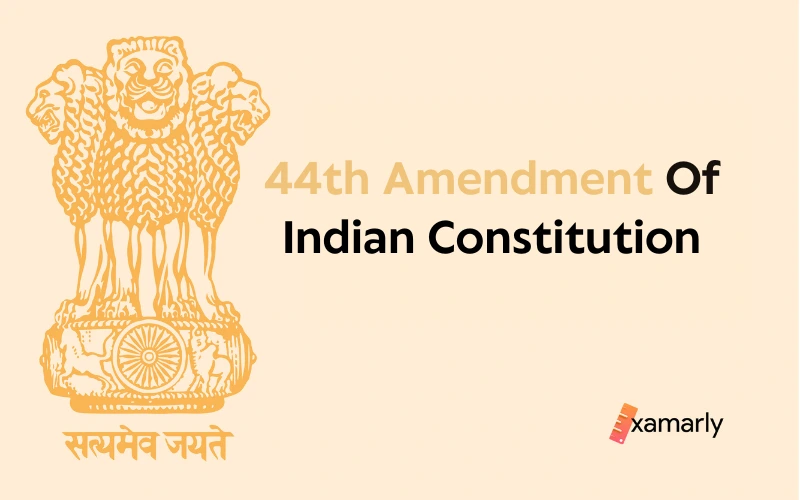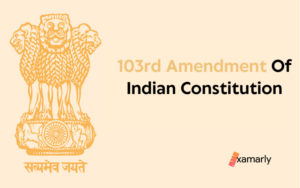By canceling and changing some of the modifications made in the 42nd Amendment Act of 1976, the 44th Amendment of the Indian Constitution made significant changes to the Constitution.
To better understand the need for such an amendment, we have to first read and understand what were the issues the previous 42nd Amendment Act presented and how did it tamper with the basic rights of Indian citizens.
In very simple terms, certain provisions of the 42nd Amendment Act made it possible to make amendments without consultation or maybe against the will of the people.
The 44th Amendment Act is a tool for changing this constitutional clause. This legislation was introduced to protect citizens against future abuses of power by the central government. Further, it aspires to reinstate democratic values in the Indian governance system and ensure the smooth working of the Constitutional Machinery.
This topic is important to any student of Indian Polity. Studying the details of this Act will help you with your UPSC CSE preparation.
Read on to further understand the provisions of the Forty-Fourth Amendment Act.
- 44th Amendment of the Indian Constitution
- 44th Constitutional Amendment Act Changes
- President’s Power
- Fundamental Rights
- Amendment to the Basic Structure
- Judiciary
- Parliamentary Privileges
- DPSP
- Parliament and State Legislatures
- President’s Rule
- Federalism
- National Emergency
- Articles 132, 133, 134 and 136
- Which Articles were Modified?
- Conclusion
- FAQs
- What does the 44th amendment of the Indian Constitution mean?
- How is the 44th Amendment of the Constitution of India related to the 42nd Constitutional Amendment?
- Which Fundamental Rights did the 44th Amendment remove?
- What does the 44th Amendment say about the Presidential rule?
- What purposes does the forty-fourth amendment of the Indian Constitution serve?
- What is the most important objective that the 44th amendment serves?
- Why Article 368 was amended?
- The Right to Property was deleted by which amendment?
44th Amendment of the Indian Constitution
In the year 1978, the 45th Amendment Bill was passed, which resulted in the incorporation of the 44th Amendment into the Indian Constitution. In 1976, the 42nd Amendment Act was passed, which resulted in a number of provisions being altered against the desire of the population.
As a result, the Forty-Fourth Amendment Act was enacted in order to revert those modifications and protect the interests of the nation.
- Shanti Bhushan proposed the 44th amendment act. He was the then Minister of Law, Justice, and Company Affairs.
- In accordance with the provisions laid down in Article 368 of the Constitution, the 44th Constitutional Amendment of the Indian Constitution was passed. More than half of India’s state legislatures approved it. These states include Andhra Pradesh, Bihar, Assam, Haryana, Gujrat, Himachal Pradesh, Madhya Pradesh, and others.
- The said amendment was enacted in the 29th year of the Indian Republic.
Apart from the 44th amendment, one can find out the most important amendments of the Indian Constitution for UPSC. If you are preparing for the civil services examination, you may find it helpful to read the article that is linked here.
44th Constitutional Amendment Act Changes
The 44th Amendment of the Indian Constitution changed the Constitution in the following ways:
President’s Power
A clause saying that the President may ask the Council of Ministers to evaluate any advice given to him was added to the updated version of Article 74 (1). The clause further states that the President is required to act on the advice offered to him after the advice has been reconsidered.
In the past, it was essential for the President to act in conformity with the recommendation that was provided by the Council of Ministers.
Fundamental Rights
- The right to property was upgraded to the rank of a legal right. This right was delisted from the list of fundamental rights.
- Both Article 31 (which dealt with the compulsory acquisition of property) and Article 19(1)(f) (which granted citizens the right to acquire, maintain, and dispose of property) have been struck from the Constitution.
- Even though the right to own property is no longer a fundamental right, minorities will still be able to establish and maintain educational institutions of their own choosing.
- The legal provision on preventative detention prevents individuals from being imprisoned for longer than three months, except when an Advisory Board finds justified grounds to do so; this further safeguards the right to liberty of persons.
- The right of the media to cover parliamentary and state legislative sessions freely and unrestrictedly is guaranteed by a special provision.
Amendment to the Basic Structure
In order for there to be any changes made to the fundamental framework of the constitution, the Indian people need to vote in favor of them in a referendum with a participation rate of at least 51% in order for there to be a majority vote in favor of the change. Article 368 has been modified in order to achieve this.
Relatable Article: Amendment Of Indian Constitution and Basic Structure Theory
Judiciary
Supreme Court and state high courts have had some of their former authority restored.
It opened the door for a judicial review of the elections for the President of India, governors, and the speaker of the Lok Sabha.
Parliamentary Privileges
The provisions of Articles 103 and 192, which deal with decisions about the disqualification of members of the Parliament and Provide Legislatures, have been changed to state that, in the event of a member of a State Legislature, the President’s decision on the matter of disqualification will be based on the opinion of the Election Commission.
DPSP
A new directive principle has been incorporated into Article 38 of the Indian Constitution, which states that the state must uphold social order in order to advance the well-being of the populace.
Parliament and State Legislatures
Through the process of amending Articles 83 and 172, the original term length of five years was reinstated for both the House of the People and the State Legislative Assemblies.
By virtue of the 42nd Constitutional Amendment of the Indian Constitution the tenure of both the Upper House and the Lower House of the Parliament was formerly increased from 5 to 6 years in the year 1976.
President’s Rule
The 44th Amendment added a new provision that limits Parliament’s ability to extend a proclamation made under Article 356 of the Indian Constitution for longer than a year.
Federalism
Article 257A of the Indian Constitution was deleted because it dealt with the central government’s ability to use its military forces or other union forces to address a crisis situation.
National Emergency
It was intended to prevent the executive from abusing emergency power.
It has added several adequate safeguards to Article 352 of the Indian Constitution. These are listed below:
- Before the 44th Amendment Act of 1978, a state of emergency could be declared on the basis of either an ongoing war, an act of external aggression, or an ongoing internal disturbance.
- The executive could abuse the internal disturbance since it was so imprecise. Therefore, “armed rebellion” was substituted for “internal disturbance” in the Act.
- After receiving a recommendation in writing from the Cabinet, only then can the President declare a state of emergency. A cabinet is defined under Article 352 of the Indian Constitution as the Prime Minister and other ministers who hold cabinet rank. A special majority is now required for approval, which was previously based on a simple majority.
- Once a declaration of emergency was authorized by parliament, there was no parliamentary oversight over it. The Lok Sabha can now convene for a special session in order to discuss disapproval.
- Article 358 states that Article 19 is only automatically discontinued when emergency provisions are proclaimed due to war or foreign aggression; in the past, it was also suspended due to internal unrest.
- During a period of emergency, it is not possible to postpone the execution of the rights granted by Articles 20 and 21. Before the Act was passed, the execution of any one of the Fundamental Rights, or all of them, might be put on hold if there was a state of emergency.
Articles 132, 133, 134 and 136
In order to prevent delays, it is suggested to change Articles 132, 133, and 134 and add a new Article 134A, which would state that a High Court should consider the issue of awarding a certificate for an appeal to the Supreme Court as soon as possible following the delivery of the relevant judgment, decree, final decision, or sentence on the grounds of an oral application by a party or, if the High Court deems it appropriate to do so, on its own initiative.
Cases that require the Supreme Court’s permission for special leave to appeal shall be left to be governed solely by Article 136.
Which Articles were Modified?
44th constitutional amendment modified the following Articles:
- Amendment of Article 19
- Amendment of Article 22
- Amendment of Article 30
- Omission of sub-heading after Article 30
- Omission of Article 31
- Amendment of Article 31A
- Amendment of Article 31C
- Amendment of Article 31C
- Amendment of Article 38
- Substitution of new article for Article 71
- Amendment of Article 74
- Amendment of Article 77
- Amendment of Article 83
- Substitution of new article for Article 103
- Amendment of Article 105
- Amendment of Article 123
- Amendment of Article 132
- Amendment of Article 133
- Amendment of Article 134
- Insertion of new Article 134A
- Amendment of Article 139A
- Amendment of Article 150
- Amendment of Article 166
- Amendment of Article 172
- Substitution of new article for Article 192
- Amendment of Article 194
- Amendment of Article 213
- Amendment of Article 217
- Amendment of Article 225
- Amendment of Article 226
- Amendment of Article 227
- Amendment of Article 239B
- Omission of Article 257A.
- Insertion of new Chapter IV in Part XII
- Amendment of Article 329
- Omission of Article 329A
- Amendment of Article 352
- Amendment of Article 356
- Amendment of Article 358
- Amendment of Article 359
- Amendment of Article 360
- Insertion of new Article 361A
- Amendment of Article 371F
- Amendment of the Ninth Schedule of the Indian Constitution
Conclusion
In accordance with the stipulations that were established by the Constitution (Forty-second Amendment) Act, legislative supremacy and powers might be used, and the rights could be easily repealed. This could cause unfairness for the Indian people and be against Indian constitutional law.
The 44th Amendment was put into effect to forestall situations like these from occurring. The 42nd Amendment’s distortions are eliminated by the 44th Amendment, which is a highly important change to the Indian Constitution. The Constitution’s 44th Amendment Act of 1978 was passed while the government was in power.
FAQs
What does the 44th amendment of the Indian Constitution mean?
The provisions of the 42nd Amendment Act that were enacted during the Emergency were rendered unconstitutional as a result of the passage of the 44th Amendment to the Indian Constitution. The Janata Government enacted the said amendment. As a result of the 44th Amendment Act, Article 368 was altered. Apart from Article 368, a number of Articles of the Indian Constitution were amended or repealed.
How is the 44th Amendment of the Constitution of India related to the 42nd Constitutional Amendment?
In 1978, the Indian government proposed the 44th Amendment Act. The act was introduced to repeal the alterations made by the 42nd Amendment Act of 1976. It overturned the 42nd Amendment Act’s provision, which empowered the government to change Article 368 of the Constitution as it saw fit. This arbitrary power granted to the government was repealed by the Forty-Fourth Amendment Act.
Which Fundamental Rights did the 44th Amendment remove?
In 1978, with the passage of the 44th Amendment, the right to property was taken off the set of fundamental rights. The constitution was amended to include a new provision, Article 300-A, which stated that no person shall be stripped of his property except by authority of law.
What does the 44th Amendment say about the Presidential rule?
The 44th Amendment adds a new provision that restricts Parliament’s power to prolong the proclamation provided Article 356 for more than a year.
What purposes does the forty-fourth amendment of the Indian Constitution serve?
During the state of emergency, the Indian National Congress under the leadership of Indira Gandhi approved a number of alterations to the Constitution, including the 42nd Amendment. The purpose of the 44th amendment of the Indian Constitution was to undo those amendments.
What is the most important objective that the 44th amendment serves?
The then events have demonstrated that a transient majority has the power to revoke constitutionally guaranteed rights, such as the rights to life and liberty, from citizens. To ensure that such a situation doesn’t happen again in the future and that the people have a significant voice in the form of government they live in, it is therefore vital to put in place proper safeguards against it. This was one of the most significant objectives of the said amendment in the Indian Constitution.
Why Article 368 was amended?
It is proposed to stipulate that certain Constitutional amendments that would affect the country’s secular or democratic character, curtail or eliminate fundamental rights, hinder or prevent free and fair elections based on adult suffrage, or jeopardize the independence of the judiciary, can only be made with the consent of the Indian people as determined by a majority of votes cast in a referendum in which at least 51 percent of eligible voters participate. To make sure of this, Article 368 was changed.
The Right to Property was deleted by which amendment?
The Right to Property ceased from being a Fundamental Right to being a Legal Right with the Forty-Fourth Amendment of the Indian Constitution.






